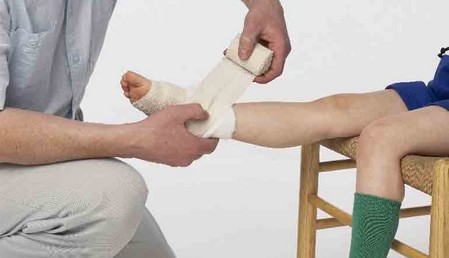If you are confident your injury is a sprained ankle, it is quite easy to take care for it yourself. Here are some steps to follow when treating an ankle sprain: RICE:
- Rest: Walk as little as possible.
- Ice: Apply ice to your ankle for the first 24 hours after the injury. Place the ice in a plastic bag and wrap a thin towel around it. Hold the ice pack in place with an elastic bandage if you have one. If you can stand it, keep the ice on your ankle for 20 minutes, then off for 40 minutes. Repeat this throughout the day.
- Compression: Gently wrap your ankle with an elastic bandage in a figure-eight pattern. This means start the bandage on the ball of the foot, alternately wrap your ankle and your instep in a figure-eight, then continue wrapping a few inches up your leg. This will help keep the swelling down and support your ankle while it heals.
- Elevation: Keep your foot higher than your heart whenever possible. You should be resting anyway, so sit or lie down with your leg on several pillows. This keeps blood from pooling in the damaged tissues.

The long-range plan for a sprained ankle
A sprained ankle can take up to two weeks to heal, but that does not mean the joint will be as strong as it was before the injury. It’s important that you give the tendons and tissues plenty of time to mend, strengthen the ankle with specific exercises, and take care not to reinjure it. For the best advice on how not to reaggravate your ankle, it’s best to visit a sports medicine doctor. A sports medicine doctor can provide you professional advice and can help you treat your ankle and get it back to 100%.
- Don’t rush the healing process. Our bodies don’t bounce back from an injury as quickly as they used to, so give your ankle lots of TLC. Stretch the muscles before you begin exercising them, rest, and wear sensible shoes.
- Try an ankle workout. It’s important not only to regain strength and flexibility in your ankle, but to restore your balance and coordination as well. Even before you begin putting any weight on the ankle, massage the muscles and do a few ankle rotations. If you have access to the beach or a pool, take a walk through the water. This will help bring down the swelling and gently strengthen the muscles. Gradually work up to more strenuous exercises. Something like the toe-crunch is easy to do, even while sitting down, and it increases the strength in your foot and ankle. Lay a small towel on the floor, and place your foot on the short edge, with half your heel on the towel and half on the floor. Curl your toes so that the towel is bunched all the way to the arch of your foot. Start out doing this 10 times, gradually increasing the number until you need more of a challenge. Then place a soup or vegetable can on the end of the towel to add resistance.
- Avoid reinjury. Too often, people don’t pay enough attention to an injury after the initial healing has taken place. You may think that everything is fine and return to life as normal. But if you’ve injured a joint that affects your movement you need to pay special attention to your home environment and daily routine. Check your house for areas where a weakened ankle could lead to trouble. Are rugs secured with some type of non-skid backing? Is there a hand grip for stepping in and out of the shower or tub? Do you have adequate lighting, both day and night, for trips up and down the stairs? If you end up on crutches due to an ankle sprain, this accident-proofing is even more important.